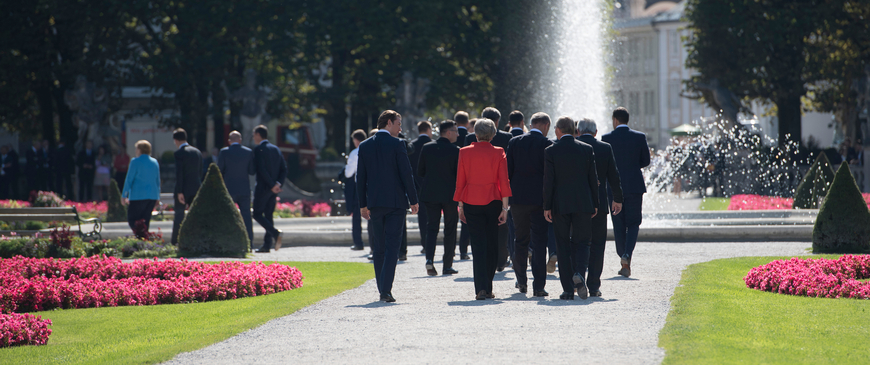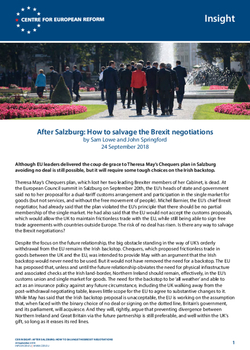
After Salzburg: How to salvage the Brexit negotiations
Although EU leaders delivered the coup de grace to Theresa May’s Chequers plan in Salzburg avoiding no deal is still possible, but it will require some tough choices on the Irish backstop.
Theresa May’s Chequers plan, which lost her two leading Brexiter members of her Cabinet, is dead. At the European Council summit in Salzburg on September 20th, the EU’s heads of state and government said no to her proposal for a dual-tariff customs arrangement and participation in the single market for goods (but not services, and without the free movement of people). Michel Barnier, the EU’s chief Brexit negotiator, had already said that the plan violated the EU’s principle that there should be no partial membership of the single market. He had also said that the EU would not accept the customs proposals, which would allow the UK to maintain frictionless trade with the EU, while still being able to sign free trade agreements with countries outside Europe. The risk of no deal has risen. Is there any way to salvage the Brexit negotiations?
Despite the focus on the future relationship, the big obstacle standing in the way of UK’s orderly withdrawal from the EU remains the Irish backstop. Chequers, which proposed frictionless trade in goods between the UK and the EU, was intended to provide May with an argument that the Irish backstop would never need to be used. But it would not have removed the need for a backstop. The EU has proposed that, unless and until the future relationship obviates the need for physical infrastructure and associated checks at the Irish land-border, Northern Ireland should remain, effectively, in the EU’s customs union and single market for goods. The need for the backstop to be ‘all weather’ and able to act as an insurance policy against any future circumstance, including the UK walking away from the post-withdrawal negotiating table, leaves little scope for the EU to agree to substantive changes to it.
Salzburg #EUCO summit delivered coup de grace to Chequers plan – Theresa May can still avoid a disastrous no-deal Brexit, but it will be tough.
While May has said that the Irish backstop proposal is unacceptable, the EU is working on the assumption that, when faced with the binary choice of no deal or signing on the dotted line, Britain’s government, and its parliament, will acquiesce. And they will, rightly, argue that preventing divergence between Northern Ireland and Great Britain via the future partnership is still preferable, and well within the UK’s gift, so long as it erases its red lines.
While it is unlikely that the EU’s offer on Northern Ireland will change substantively, as indicated by Barnier and others, there is scope for softening around the edges, and reducing the need for checks between Northern Ireland and Great Britain. A customs border, if not a regulatory one, could also be prevented if the UK were to remain in a customs union with the EU after the transition period ends, either temporarily or permanently. It remains to be seen whether May could agree to this and keep her job, or whether the British parliament would sign off on such a deal.
1. De-dramatisation
Barnier has often talked about his desire to ‘de-dramatise’ the backstop in the British debate. This does not mean that the EU is entertaining the idea of revising its stance on the backstop, but Barnier has indicated the EU can be flexible, and said that not all of the necessary checks have to be carried out in Northern Irish and British ports. It might also be possible to reduce the direct oversight of Northern Ireland’s border and regulatory institutions by the European Commission and the European Court of Justice. There are already checks at the Port of Larne in Northern Ireland on imports of live animals from Great Britain, and, so the argument goes, extending these checks to all food products would be a matter of increased scope, not creating something new. Of the four most relevant types of checks – on customs, regulations and standards, value added tax, and animal and plant hygiene – only the last, for which the infrastructure already partially exists, explicitly needs to be carried out in the ports rather than online, in distribution centres or on the ferries themselves.
In the event of the backstop coming into effect, Northern Ireland would be in a separate customs territory to the rest of the UK, but this would have no impact on Northern Ireland’s constitutional status as a component part of the UK, which is enshrined in the Good Friday Agreement. Other nations manage similar arrangements with little fuss: the Canary Islands are outside the EU’s VAT area, despite being a constituent region of Spain, which necessitates checks. Indeed, having a foot in both camps could be to Northern Ireland’s economic advantage, and is perhaps the only workable half-way house for the six counties, which overwhelmingly voted to remain. Fresh elections to the devolved government in Northern Ireland, which has been suspended since January 2017, may be needed to get public consent for such a move. But an opinion poll by the UK in a Changing Europe think-tank found that 49 per cent of Northern Irish people would be prepared to accept a border in the Irish Sea, with 39 per cent opposed.
2. Conditional bolt-ons
While the withdrawal agreement will probably only bind both sides to a Northern Ireland-specific backstop, it could allow for whole UK solutions, that would be conditional – and this is important – on the future, post-withdrawal, consent of both the UK and EU. This would ensure the backstop remains all-weather – if the UK walked away from the negotiating table it would still apply to Northern Ireland – yet opens up the option of partial extension to the whole UK.
For example, the withdrawal agreement text on the backstop could state that, conditional on future agreement by both the EU and UK, a temporary customs union (perhaps similar to that proposed by the UK at the beginning of the summer) could be extended to the UK. That customs union would last until both the EU and the UK agreed upon a long-term solution for Northern Ireland. The time-limited union would remove the need for some checks relating to customs, if not all regulatory checks.
Another option that could be triggered is a time-limited extension to the transition period. The current draft withdrawal agreement does not enable the parties to extend the transition, but the EU might agree to introduce a ‘revision clause’ which would allow for the extension beyond 2020. That would give both parties more time to agree a deal over Northern Ireland and the overall UK-EU relationship, if it were required.
Neither party would be bound to agree on either an extension of the transition or a temporary customs union for all of the UK, but including either option in the Brexit deal now would push back the earliest time that the Northern Irish-specific backstop could come into effect. That could provide May some cover domestically.
3. A long-term customs union
May – or her successor – could sign a political declaration that declares that the two sides will seek to negotiate a customs union as the end state, removing the need for a customs border in the Irish Sea. The Chequers plan for a complicated customs arrangement and UK participation in the single market for goods would be replaced by UK membership of a customs union in industrial goods and agricultural products.
Britain would have to accept constraints on its ability to negotiate trade agreements covering tariffs and quotas with countries outside Europe. This may only be feasible if May’s government falls, since she would probably face a leadership challenge from hardliners in her cabinet if she abandons plans for ‘global Britain’. A Labour government may seek to negotiate such an arrangement. Or a temporary customs union may, in time, evolve into something permanent.
A long-term customs union would reduce the number of checks necessary between Northern Ireland and Great Britain, since tariffs and rules of origin would not be an issue. And, as tempers cool over time – and if the wave of populism that currently threatens the EU recedes – it may be possible to bolt on shared rules and standards to the customs union, so that it gets closer to membership of the single market in goods. This strategy would amount to a ‘de-dramatisation’ of Chequers in order to make it more palatable to the EU, but it would not remove the need to agree a backstop.
How can Theresa May resolve the NI backstop after Salzburg? de-dramatisation, conditional bolt-ons, a long-term customs union.
Ultimately, none of what has been laid out here will be easy for any British government to swallow. Yet, it is difficult to see any other way out. May will put forward her own additional proposal for the Irish backstop in the coming months, but unless she changes her usual approach – of making all-UK proposals for the future relationship under the cover of a fall-back solution for Ireland – it will inevitably be met with hostility. To compound matters further, the political declaration on the future relationship, while not being legally binding, will need to set out a destination that is both loose enough to convince those in her party who want a harder Brexit that their vision is still in play, and deep enough that it would arguably prevent the need for a separate solution for Northern Ireland.
This all suggests, despite claims to the contrary, that the negotiations could well run into the New Year. If the UK is to capitulate, as the EU expects it will, it is difficult to see it happening while there is still time to negotiate further. While the imminent threat of no deal in March next year will depress sterling and business investment in the UK, it may end up being the only thing that scares May and Parliament into reluctantly accepting the backstop, which is a lesser evil than no deal. It also suggests that the tone of the negotiations will become much worse before it gets better.
Sam Lowe is a senior research fellow and John Springford is deputy director of the Centre for European Reform.


Comments
But this is just Chequers by another name. Another attempt to cherry-pick. It will be as firmly rejected as the last one.
The EU has roughly 3 choices: CETA (Canada), CU (Turkey) or EEA (Norway + CU). Red lines must be crossed, or economic apocalypse will incur.
Add new comment